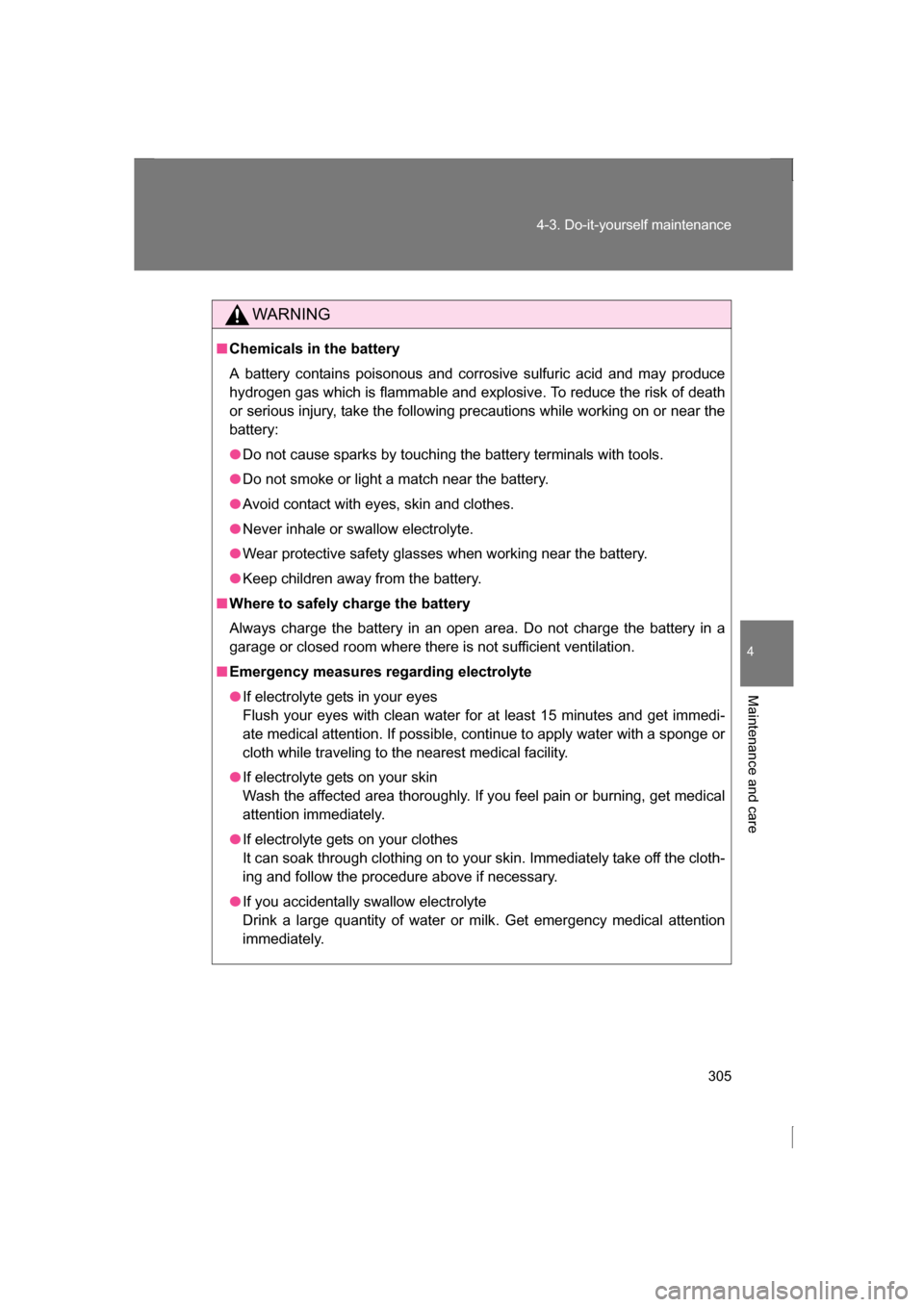Page 305 of 484

305
4-3. Do-it-yourself maintenance
4
Maintenance and care
WARNING
■Chemicals in the battery
A battery contains poisonous and corrosive sulfuric acid and may produce
hydrogen gas which is flammable and explosive. To reduce the risk of death
or serious injury, take the following precautions while working on or near the
battery:
●Do not cause sparks by touching the battery terminals with tools.
●Do not smoke or light a match near the battery.
●Avoid contact with eyes, skin and clothes.
●Never inhale or swallow electrolyte.
●Wear protective safety glasses when working near the battery.
●Keep children away from the battery.
■Where to safely charge the battery
Always charge the battery in an open area. Do not charge the battery in a
garage or closed room where there is not sufficient ventilation.
■Emergency measures regarding electrolyte
●If electrolyte gets in your eyes
Flush your eyes with clean water for at least 15 minutes and get immedi-
ate medical attention. If possible, continue to apply water with a sponge or
cloth while traveling to the nearest medical facility.
●If electrolyte gets on your skin
Wash the affected area thoroughly. If you feel pain or burning, get medical
attention immediately.
●If electrolyte gets on your clothes
It can soak through clothing on to your skin. Immediately take off the cloth-
ing and follow the procedure above if necessary.
●If you accidentally swallow electrolyte
Drink a large quantity of water or milk. Get emergency medical attention
immediately.
Page 306 of 484
306
4-3. Do-it-yourself maintenance
Washer fluidIf the washer fluid level is at
“LOW”, add washer fluid.
CAUTION
■When recharging the battery
Never recharge the battery while the engine is running. Also, be sure all
accessories are turned off.
■When adding distilled water
Avoid overfilling. Water spilled during battery recharging may cause corro-
sion.
■Using the gaugeThe washer fluid level can be checked by
observing the position of the level on the
liquid-covered holes in the gauge.
If the level falls below the second hole
from the bottom (the “LOW” position),
refill the washer fluid.
CTH43AS134
Current
fluid level
Page 325 of 484
325
4-3. Do-it-yourself maintenance
4
Maintenance and care
Transmitter/access key batter y
Replace the battery with a new one if it is depleted.
■You will need the following items: ●Flathead screwdriver
● Lithium battery CR2016 (vehicles without a keyless access
with push button start system), or CR1632 (vehicles with a
keyless access with push button start system)
■Replacing the battery (vehicles without a keyless access
with push button start system)
Remove the cover.
To prevent damage to the key,
cover the tip of the screwdriver
with a rag.
To prevent the buttons from
being disassembled, face the
button surface downward.
Remove the module.
STEP1
STEP2
Page 326 of 484
326
4-3. Do-it-yourself maintenance
Open the case cover using a
coin protected with tape and
remove the depleted battery.Insert a new battery with the
“+” terminal facing up.
■Replacing the battery (vehicles with a keyless access with
push button start system) Take out the mechanical key.
Remove the cover.
To prevent damage to the key,
cover the tip of the screwdriver
with a rag.
STEP3
STEP1
STEP2
Page 327 of 484

327
4-3. Do-it-yourself maintenance
4
Maintenance and care
■Use a CR2016 (vehicles without a keyless access with push button
start system) or CR1632 (vehicles with a keyless access with push but-
ton start system) lithium battery
●Batteries can be purchased at your SUBARU dealer, local electrical
appliance shops or camera stores.
●Replace only with the same or equivalent type recommended by the
manufacturer.
●Dispose of used batteries according to local laws.
■If the key battery is depleted
The following symptoms may occur:
●The keyless access with push button start system (if equipped) and
remote keyless entry system will not function properly.
●The operational range will be reduced.
■When putting the module back (vehicles without a keyless access with
push button start system) Remove the depleted battery.
Insert a new battery with the
“+” terminal facing up.
STEP3
Insert the module from directly above.
Inserting it on an angle may prevent the
key buttons from operating properly.
Page 328 of 484
328
4-3. Do-it-yourself maintenance
WARNING
■Removed battery and other parts
Keep away from children. These parts are small and if swallowed by a child,
they can cause choking. Failure to do so could result in death or serious
injury.
CAUTION
■For normal operation after replacing the battery
Observe the following precautions to prevent accidents:
●Always work with dry hands.
Moisture may cause the battery to rust.
●Do not touch or move any other component inside the remote control.
●Do not bend either of the battery terminals.
Page 353 of 484
When trouble arises5
353
5-1. Essential informationHazard warning flashers .......................... 354
If your vehicle needs to be towed ........................ 355
If you think something is wrong ......................... 362
Fuel pump shut off system ........................... 363 5-2. Steps to take in an
emergency
If a warning light turns on or a warning buzzer
sounds... ....................... 364
If you have a flat tire......... 378
If the engine will not start ................................ 389
If the select lever cannot be shifted from P ............ 392
If you lose your keys ........ 393
If the access key does not operate properly....... 394
If the battery is discharged ..................... 398
If your vehicle overheats ....................... 403
If the vehicle becomes stuck .............................. 406
Page 354 of 484
354
5-1. Essential information
Hazard war ning flashers
■Hazard warning flashers
If the hazard warning flashers are used for a long time while the engine is
not operating, the battery may discharge.
The hazard warning flashers are used to warn other drivers when the
vehicle has to be stopped in the road due to a breakdown, etc.
Press the switch.All the turn signal lights will
flash. To turn them off, press
the switch once again.